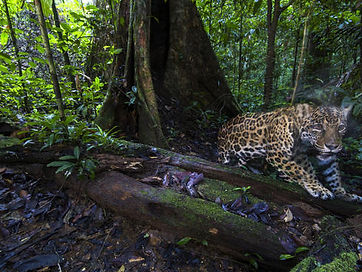
8/28/20
Jaguar
Jaguars, or Panthera onca, are the third biggest big cat in the world. Jaguars are very similar to leopards. Leopards live in Africa and Asia, however, and the jaguar’s spots are more complex and usually have a dot in the middle. They are also more stockier than leopards. Jaguars can climb trees and are excellent swimmers. In fact, much of their prey, including fish, turtles and caimans, live in the water. Jaguars also eat land animals, including deer, peccaries, capybaras, and tapirs. Jaguars have a different method of killing prey than all other cats. They use their powerful jaws to pierce their captured prey’s skulls. Jaguars are solitary, territorial animals. The exception to this is when mother jaguars have cubs. Jaguars have 1-4 cubs, and the mother stays with them for about 2 years to defend against any possible threats and to teach them how to hunt. Historically, jaguars were found from Argentina all the way to the southwestern United States, but they were hunted to extinction in the U.S. They mostly live in rainforests but can be found in savannas, grasslands, and even deserts. Most jaguars currently live in the Amazon basin, with smaller populations in drier areas.
The main reason that jaguars are endangered is deforestation and habitat loss. Poaching and the killing of jaguars to protect livestock is also a problem. Deforestation is a big problem because it destroys and fragments habitats, causing many problems for jaguars. Fragmented habitat, because of deforestation or other reasons, forces jaguars into small areas. This means they won’t be able to travel far enough to find mates, leading to inbreeding and local extinctions. As more and more forest is cut down and replaced with grazing land and jaguars prey gets scarce, jaguars start to hunt cattle for food. Because of this cattle owners are forced to kill jaguars to protect their livestock. Poaching is also becoming more of a problem, and jaguars are hunted for their pelts, bones, and teeth. Because of all this jaguars have been classified as near threatened by the IUCN, and are threatened enough to cause every country they live in to protect them.

The main underlying reason that jaguars are endangered is deforestation. Deforestation effects all the animals in the area, including jaguars and humans. Deforestation and other human problems also cause the numbers of prey to decline, which also affects jaguars. Because of this, jaguars can be a warning sign, and show people the effects of deforestation. Jaguars also are important to the ecosystem they live in because they control prey populations and maintain a healthy environment.
There are several things organizations and people are doing to help jaguars. For example, there are many efforts to create wildlife corridors between isolated populations in small disconnected patches of livable habitat created by deforestation. This prevents inbreeding and promotes genetic diversity, helping jaguar cubs survive. Another thing organizations are doing is working with ranchers to help reduce human-jaguar conflict, for example compensating ranchers for lost cattle, and working on ways to make sure jaguars can get enough prey without eating cattle. You can help by supporting organizations that do these things and by raising awareness for the jaguar.




Works Cited
“Jaguar.” National Geographic, National Geographic Society. https://www.nationalgeographic.com/animals/mammals/j/jaguar/. Accessed 24 August 2020.
“Jaguar Facts.” Big Cat Rescue. July 27 2015 https://bigcatrescue.org/jaguar-facts/. Accessed 24 August 2020.
“Jaguar: The Amazing Amazon Big Cat.” World Wildlife Fund. https://www.worldwildlife.org/stories/jaguar-the-amazing-amazon-big-cat. Accessed 24 August 2020.

